The COVID-19 pandemic is the defining global health crisis that the world is currently facing. The virus has spread all over the world, and the number of cases is rising every single day as governments work to slow its spread. The global response to the unfolding COVID-19 crisis saw countries implementing countrywide or partial lockdowns, the announcement of stimulus packages and relief measures to tackle the harsh economic impact of the pandemic. The virus also overwhelmed the global production capacity of PPE which is the most critical product to protect the front-line health workers and other responders. Surging demand for PPE kits along with disrupted global supply chain amid the Covid-19 pandemic was putting lives at risk.

India moved quickly, implementing a nationwide lockdown with the goal of flattening the curve and using the time to plan resource responses, adequately. The Prime Minister assured the country that there are ample reserves of medicines, PPE kits, food and other essential goods.
India realized the critical role of PPE in combating this pandemic as early as March, wherein the Ministry of Textiles stepped to lead the assessment of the availability of all protective wears for our frontline health workers.
What followed this, is a remarkable journey of collaboration between governments at the central and state levels, industries and workers to revamp existing production lines to manufacture a completely unknown product, from scratch.
- From 0, India now produces nearly 4.5 lakh PPE kits every single day.
- In 60 days, the PPE industry in India has witnessed 56 times growth.
This is a testimony to the government of India’s concerted efforts of improving domestic manufacturing capacity on the back of its industrious manufacturing sector at such challenging times. Before we proceed further, we must understand what PPE exactly is.
What is Personal Protective Equipment (PPE)?
Personal Protective Equipment (PPEs) are protective gears designed to safeguard the health of workers by minimizing the exposure to a biological agent. PPEs include goggles, face-shield, masks (Surgical/N-95), gloves (surgical/examination), coverall/gowns (with or without aprons), head cover and shoe cover.

The Ministry of Health and Family Welfare released a set of guidelines for the rational use of PPE for health care workers and for others who work at various point of entries, quarantine centres, hospitals, laboratories, primary healthcare and community settings.
The guidelines emphasize the need to select the right type of PPE based on the estimated risk of contamination, the reuse of PPEs when there is a shortage and, the procedures to be followed on how to wear them.
Increasing commercial activity blamed for rising noise levels in residential areas
Bengaluru, which figured on the list of 150 most polluted cities in the world in the recently released urban air pollution database of the World Health Organisation (WHO), has more to worry about than just air pollution. Noise pollution levels, too, have been consistently higher than permissible limits, especially in the residential and sensitive areas.
Air pollution levels monitored by the Karnataka State Pollution Control Board (KSPCB) during 2015–16 show that the respirable suspended particulate matter (RSPM) values exceeded the national ambient air quality standards (60 μg/m{+3}) in the range of 20 to 215 per cent.
The RSPM levels near two hospitals in the city — Victoria and the Indira Gandhi Institute of Child Health Hospital in NIMHANS — had also exceeded the desired levels by 66 and 88 per cent, respectively.
The irony, though, was in the noise pollution levels, which were constantly above limits in residential and sensitive areas, more so during the night time. Noise levels in industrial areas, on the other hand, stayed within limits. Apart from having higher permitted levels, KSPCB officials said activity in these areas was concentrated around certain durations, with most people coming to work and leaving at around the same time. “On the other hand, activities are spread across the day in residential and commercial areas,” a senior official explained.
KSPCB officials attributed the rising noise levels in many residential areas across the city to increasing commercial activity seeping in.
Nitin Sheshadri, a resident of Koramangala who has been crusading against commercialisation of residential areas, said it was no surprise that residential areas were beating industrial ones in pollution levels.
“It is a twin problem. Commercialisation brings in more traffic into residential areas, and with this pollution owing to the extra footfall. The additional traffic is contributing heavily to the noise level. In addition, industrial generators are being used in restaurants, eateries and spaces which need 24×7 power backup, which do not apply to these conditions,” he said, and added that in Koramangala, pubs and bars were affecting the residents.
KPSCB chairman Lakshman said the noise levels were especially higher during the peak hours owing to the traffic and slow movement of vehicles. “We are getting complaints from residents near small commercial establishments, shops and restaurants. We are regularly monitoring wherever we are getting complaints from, controlling the noise level in generator sets. Notices have also been issued to many to rectify the diesel sets,” he said.
It is no surprise that residential areas are beating industrial ones in pollution levels
Nitin Sheshadri, a resident of Koramangala

